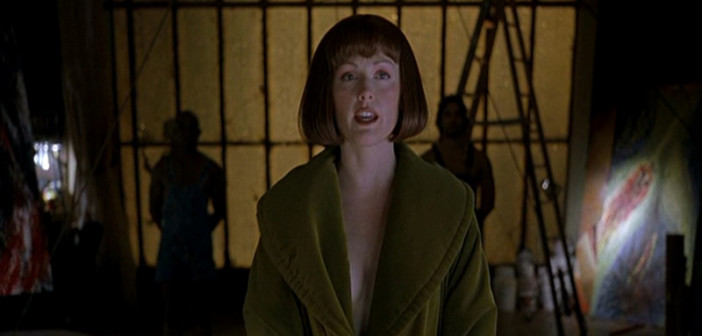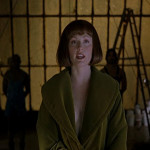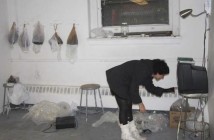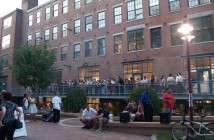Just as it’s expected that rock bands rail against the machinations of the music industry, and indie filmmakers lament the hollowness of Hollywood, it’s a condition of those working in or with art that the ‘art world’ be berated as something lacking in the authentic dedication to art, beauty, ideas (etc) to be found, presumably, in the practice of the speaker. Further, it’s a condition of those working in the art world that the phrase ‘art world’ be used to denote something intrinsically different from the speaker’s own position. The ‘art world’ described by these people (let’s call them "us") is exactly consonant with that of the ‘art world’ described in various media outlets: a religion with its own iconography (large things, shiny things, dead things), its own clergy (the international curatorhood), its own sub-cults (‘Gallery Girls’, Twitter); its own missionary practices (art fairs, biennials), pilgrimage sites (art fairs, biennials) and sainted dates (art fairs, biennials); its own creation narratives (Duchamp, Warhol, Sherman), its own internal structures of unchecked, hush-hush ethics (the art market, the gallery system), and, most contentiously of all, its own liturgy (press releases, catalogue essays, magazine pieces), which is Biblical, not Talmudic, meaning that it’s the text, not a text.
We self-loathing art-worlders love to snort at the semantic loop-the-loops of the bad press release, with its clunky phrasing, like ‘semantic loop-the-loops’, or protracted and laboured analogies, like comparing the art world with organized religion. But bemoaning the art world’s singular approach to language — which is fun, obviously — means something different for those who of us actually work within the ‘art world’, regardless of how quick we are to disassociate ourselves from it. Implied within our sarcastic quotation of press release banalities (‘problematic’, ‘discourse’, ‘space’, ‘ practice’, ‘dialectic’, ‘abject’, ‘tension’, ‘radical’, ‘subversive’, and all possible permutations of intra-parenthesised polysyllables) is the idea that the art itself is actually pretty straightforward and can be encapsulated in a clutch of simple words. Why over-complicate it? It’s the intellectual equivalent of the suited square in the classic Ad Reinhardt cartoon, snarking at an abstract painting with the line, "Ha ha — What does this represent?", to which the painting angrily responds, "What do you represent?". The square is us.
It’s so easy to laugh, it’s so easy to hate: it takes guts to actually explain what the hell contemporary art is all about. Laughing at the art world’s lax approach to semantics throws the onus back upon the laugher: OK, so the language is absurd, but no more or less than the art it purports to describe. We scorn-pourers presume that the language is inappropriately used, but don’t seem willing to propose a better, more accurate or efficient kind of language to replace it: so we laugh, and retweet, and moan, implying that we understand, and possess the right language to address the art. But we don’t. Or if we do — and this is worse — we won’t use it.
The thing is that contemporary art and the way it’s discussed — in press releases, dissertations, text messages and speed dating banter — are one and the same thing. The professionalization of artistic practice, with its emphasis on artists’ statements and the academic blitzkrieg of the crit, has bound the act of making with that of describing, so that many works of contemporary art seem to enter the world backwards, text-first. In a sense, the dead clauses of the press release are mere continuations of discussions that began before the thing was made. Or retroactively begun, by artists looking to elbow their way into the art world; regardless, the use of press release art-speak in your statement is no different than complying with a dress code. Its use is a way of showing you get the parameters of the party. That you — and your work - are willing to participate in society, be it in the form of a white tuxedo or a polyurethane sculpture of the eBay logo.
| The professionalization of artistic practice has bound the act of making with that of describing, so that many works of contemporary art seem to enter the world backwards, text-first. |
What the work looks like is secondary. The question posed by Triple Canopy in their article on ‘IAE’ (‘International Art English’, the authors’ term for ‘artspeak’) — ‘Can we imagine an art world without IAE?’ — doesn’t go far enough. We ought to ask, ‘Can we imagine art without IAE?’ Can we imagine experiencing a work of contemporary art free of the veils of language that clutter visual experience? Is contemporary art even possible without a carapace of agreed-upon intellectual jargon? Can it exist?
Insecurity, of course, is behind it all. Fear that what we’re doing might be useless or frivolous has defined some of the crucial artistic positions of the last century, from Pollock’s shoot-first public persona to Matthew Barney’s sombre camp (notice how much his college football background is mentioned by pale, bird-chested curators eager to hang out with the popular dudes). The art world’s use of complexly conjoined adjectives is of a piece with this anxiety: it’s a supreme conceptual act of self-elision, language that multiplies itself in order to say less, to say nothing. This language literally occupies the intellectual space of engaged and thoughtful critical analysis: it takes up the space of other words. For contemporary art to be free of the laboured language that has clogged its comprehension for the last 20 or 30-odd years, it has to stop acting like contemporary art. This requires accepting the parameters of what contemporary art is, and acknowledging the long shadow that a professionalised art language has of late cast over the making of art. That grimly serious language —born of insecurity about the frivolity of the creative act (an anxiety that, let’s not forget, fails to trouble Tom Cruise, or Beyoncé, or the Blue Man Group) — might shrivel once it’s amputated from the act of making, like a vestigial wing or thumb for which we can’t remember ever having found a use.
- Ad Reinhardt (1913-67)
- Julianne Moore in The Big Lebowski as Maude Lebowski.






